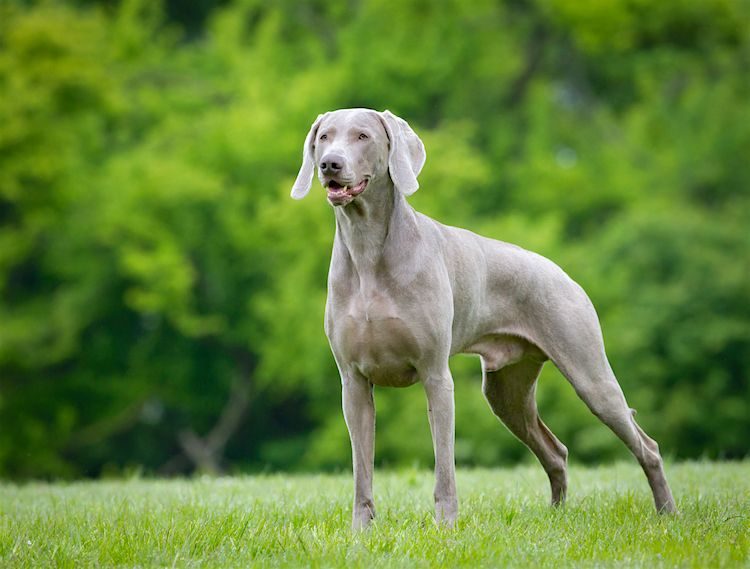
Sporting
70-90 lbs. (male);
55-75 lbs. (female)
25-27 in. (male);
23-25 in. (female)
10-13 years
Table of Contents
Key Characteristics of Weimaraners
Weimaraners (a.k.a. Weims) are muscular, large dogs with big ears that hang down the sides of the head.
They are often referred to as “gray ghosts” for their unique gray coat colors. Their coats are smooth and short, with occasional white markings on the chest.
The dewclaws are usually removed and the tails docked, but these practices are illegal in some countries, and growing support worldwide seeks to outlaw them.
Where Weimaraners Came From
Weimaraners originated in Germany as big-game hunters of bears and deer, and the dogs were used by the nobles of Weimar for their exceptional speed, tracking ability and resilience.
The dogs were prized and strictly guarded, and the Germans created a Weimaraner club in which only members were allowed to keep and breed Weimaraners.
As large game decreased, the dogs were used as hunting companions and for smaller game, such as birds.
Club member Howard Knight, an American, wanted to breed the dogs in the United States, and in the late 1930s, he did exactly that. Knight formed the Weimaraner Club of America and created a breed standard.
The American Kennel Club (AKC) accepted the breed in 1943.

How Friendly Are Weimaraners?
Weimaraners are intelligent, friendly, affectionate and active dogs who love people and children.
Most Weim lovers will tell you their dogs love to give standing hugs and typically take over the bed for sleeping.
Protective and loyal, these dogs seem fearless. They are great watchdogs, but some may bark excessively and need additional training.
Weimaraners are easy to train, learn quickly and have a natural desire to please. Because they are active dogs, give your Weim proper training — if left untrained, the dog will think they’re the pack leader and make future training difficult.
Never use physical force or reprimands to discipline a Weimaraner — they’ll remember it and go out of their way to avoid you or ignore commands and training. Instead, use positive reinforcement.
Weimaraners are large enough to knock over young children, so supervise yours when they’re around kids or small prey animals.
Beyond that, these dogs are great with children and also work as therapy dogs for the young and elderly. Their tracking abilities are excellent for specific jobs, such as detecting pests.
Is This the Right Dog for You?
Exercise Needs
HIGH: Weimaraners were born to run and need consistent, daily exercise and play.
A bored Weimaraner can become rambunctious, destructive and difficult to control. Most dogs of this breed are happiest when given a job or task to perform regularly. They love to work and to be praised.
They are prone to separation anxiety and don’t enjoy being crated or kenneled for a long time.
Don’t make them live in outdoor kenneling — Weimaraners want to be with their family and may become distressed without regular contact.
“You just have to love the workings of their ingenious, overactive minds,” says AKC judge Carole Lee Richards. “It would be so much easier to love a docile, ‘all I want to do is please you’ breed, but it will never replace the challenge and reward of being a Weimaraner owner.”
“Love them for what they are, and don’t forget there’s nothing in the world like a Weimaraner,” she adds.
Grooming Needs
LOW: The coat of a Weimaraner is short and easy enough to maintain.
Bathe your Weim only when needed, and a once-a-week brushing is usually sufficient for this average shedder.
Trim the nails regularly and clean the teeth and ears. Also, inspect the paw pads and undercarriage for debris or injuries after every outing.
Health Problems
MEDIUM: The most common problem in medium to larger dogs is bloat/gastric dilatation-volvulus (GDV).
“Statistically, we know that large, deep-chested breeds are more prone to GDV,” notes Dr. Ernest Ward, DVM. In fact, he says, “in a recent study, the top 3 breeds found to be at risk of bloat were Great Dane, Saint Bernard and Weimaraner.”
Besides bloat, also watch out for these common conditions in Weimaraners:
- Hip dysplasia
- Hypertrophic osteodystrophy (HOD)
- Skin allergies
- Excessive growth
- Tumors
More Stats About Weimaraners
| Friendliness | ★★★★☆ |
| Ease of Training | ★★★★☆ |
| Barking/Howling | ★★☆☆☆ |
| Shedding | ★★★★☆ |
| Tolerate Being Alone | ★☆☆☆☆ |
| Very Good With Kids | ★★★★☆ |
It’s OK, puppy — you can just lie down if you want to sleep:
How to Adopt a Weimaraner
Weimaraners need exercise and attention from their families, and many people get one without realizing the effort needed to keep them healthy and happy. This is one of the many reasons you can find often Weimaraners in animal shelters and rescues.
Considering a Weimaraner for your next pet? Check rescues and adoption resources first. Even purebred animals can end up in shelters. Try Petful’s adoption center.
If you decide to go with a breeder, read this list of puppy mill warning signs to ensure your chosen breeder is reputable.
“Reputable breeders know the Weimaraner. They will have spent time and money proving that the sire and the dam are physically and mentally sound, and fit the breed standard,” writes Susan Fox in her book Weimaraners: A Complete Pet Owner’s Manual. Reputable breeders will also have checked for potential hereditary diseases and properly socialized the puppies, she adds.
References
- “Weimaraner.” American Kennel Club. https://www.akc.org/dog-breeds/weimaraner/.
- “The History of the Weimaraner.” Weimaraner Club of America. https://www.weimaranerclubofamerica.org/history.php.
- Richards, Carole Lee. “Living With a Weimaraner.” Weimaraner Club of America. https://www.weimaranerclubofamerica.org/living_with_a_weim.php.
- Richards, Carole Lee. “Weimaraner Owners Are Weird.” AKC Gazette. July 2016. https://weimaranerclubofamerica.org/Gazette/Weimaraner_Owners_Are_Weird.pdf.
- Fox, Susan. Weimaraners: A Complete Pet Owner’s Manual. B.E.S. Publishing. 2011. 27.
- Ward, Ernest, DVM. “Bloat: Gastric Dilatation and Volvulus in Dogs.” VCA Animal Hospitals. https://vcahospitals.com/know-your-pet/bloat-gastric-dilatation-and-volvulus-in-dogs.
- Burnell, Kim. “Weimaraner Health Problems.” Barrett Weimaraners. March 13, 2014. http://www.barrettweimaraners.com/weimaraner-health-problems/.
- Burnell, Kim. “How to Find a Reputable Weimaraner Breeder.” Just Weimaraners. Dec. 15, 2014. Archived at https://web.archive.org/web/20170105042056/https://www.justweimaraners.com/pdf/reputable-breeder-justweimaraners.pdf.









